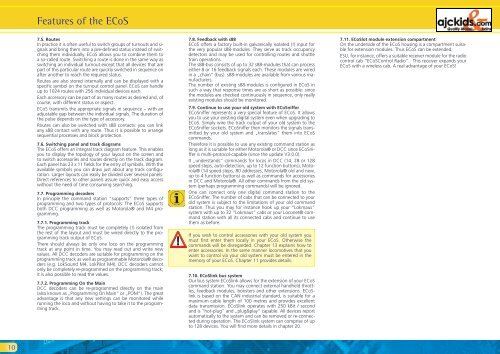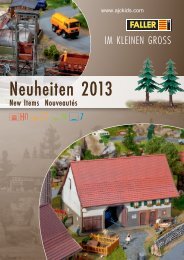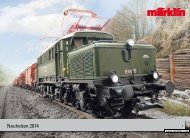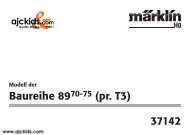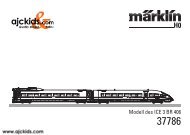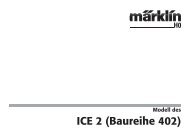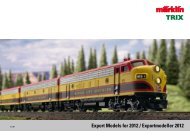User Manual - Ajckids.com
User Manual - Ajckids.com
User Manual - Ajckids.com
You also want an ePaper? Increase the reach of your titles
YUMPU automatically turns print PDFs into web optimized ePapers that Google loves.
10<br />
Features of the ECoS<br />
7.5. Routes<br />
In practice it is often useful to switch groups of turnouts and signals<br />
and bring them into a pre-defined status instead of switching<br />
them individually. ECoS allows you to <strong>com</strong>bine them to<br />
a so-called route. Switching a route is done in the same way as<br />
switching an individual turnout except that all devices that are<br />
part of this particular route are quickly switched in sequence on<br />
after another to reach the required status.<br />
Routes are also stored internally and can be displayed with a<br />
specific symbol on the turnout control panel. ECoS can handle<br />
up to 1024 routes with 256 individual devices each.<br />
Each accessory can be part of as many routes as desired and, of<br />
course, with different status or aspect.<br />
ECoS transmits the appropriate signals in sequence – with an<br />
adjustable gap between the individual signals. The duration of<br />
the pulse depends on the type of accessory.<br />
Routes can also be switched with s88 contacts: you can link<br />
any s88 contact with any route. Thus it is possible to arrange<br />
sequential processes and block protection.<br />
7.6. Switching panel and track diagrams<br />
The ECoS offers an integral track diagram feature. This enables<br />
you to display the topology of your layout on the screen and<br />
to switch accessories and routes directly on the track diagram.<br />
Each panel has 23 x 11 fields for the entry of symbols. With the<br />
available symbols you can draw just about any track configuration.<br />
Larger layouts can easily be divided over several panels.<br />
Direct references to other panels assure quick and easy access<br />
without the need of time consuming searching.<br />
7.7. Programming decoders<br />
In principle the <strong>com</strong>mand station “supports” three types of<br />
programming and two types of protocols: The ECoS supports<br />
both DCC programming as well as Motorola® and M4 programming.<br />
7.7.1. Programming track<br />
The programming track must be <strong>com</strong>pletely (!) isolated from<br />
the rest of the layout and must be wired directly to the programming<br />
track output of ECoS.<br />
There should always be only one loco on the programming<br />
track at any point in time. You may read out and write new<br />
values. All DCC decoders are suitable for programming on the<br />
programming track as well as programmable Motorola® decoders<br />
(e.g. LokSound M4, LokPilot M4). DCC decoders cannot<br />
only be <strong>com</strong>pletely re-programmed on the programming track;<br />
it is also possible to read the values.<br />
7.7.2. Programming On the Main<br />
DCC decoders can be re-programmed directly on the main<br />
(also known as „Programming On Main“ or „POM“). The great<br />
advantage is that any new settings can be monitored while<br />
running the loco and without having to take it to the programming<br />
track.<br />
7.8. Feedback with s88<br />
ECoS offers a factory built-in galvanically isolated (!) input for<br />
the very popular s88-modules. They serve as track occupancy<br />
detectors and may be used for controlling routes and shuttle<br />
train operations.<br />
The s88-bus consists of up to 32 s88-modules that can process<br />
either 8 or 16 feedback signals each. These modules are wired<br />
in a „chain” (bus). s88-modules are available from various manufacturers.<br />
The number of existing s88-modules is configured in ECoS in<br />
such a way that response times are as short as possible: since<br />
the modules are checked continuously in sequence, only really<br />
existing modules should be monitored.<br />
7.9. Continue to use your old system with ECoSniffer<br />
ECoSniffer represents a very special feature of ECoS. It allows<br />
you to use your existing digital system even when upgrading to<br />
ECoS. Simply wire the track output of your old system to the<br />
ECoSniffer sockets. ECoSniffer then monitors the signals transmitted<br />
by your old system and „translates” them into ECoS<br />
<strong>com</strong>mands.<br />
Therefore it is possible to use any existing <strong>com</strong>mand station as<br />
long as it is suitable for either Motorola® or DCC since ECoSniffer<br />
is multi-protocol-capable (since the update V3.0.0).<br />
It „understands” <strong>com</strong>mands for locos in DCC (14, 28 or 128<br />
speed steps, auto-detection, up to 12 function buttons), Motorola®<br />
(14 speed steps, 80 addresses, Motorola® old and new,<br />
up to 4 function buttons) as well as <strong>com</strong>mands for accessories<br />
in DCC and Motorola®. All other <strong>com</strong>mands from the old system<br />
(perhaps programming <strong>com</strong>mands) will be ignored.<br />
One can connect only one digital <strong>com</strong>mand station to the<br />
ECoSniffer. The number of cabs that can be connected to your<br />
old system is subject to the limitations of your old <strong>com</strong>mand<br />
station. Thus you may for instance hook up your “Lokmaus”<br />
system with up to 32 “Lokmaus” cabs or your Loconet® <strong>com</strong>mand<br />
station with all its connected cabs and continue to use<br />
them as before.<br />
If you wish to control accessories with your old system you<br />
must first enter them locally in your ECoS. Otherwise the<br />
<strong>com</strong>mands will be disregarded. Chapter 13 explains how to<br />
enter accessories. In the same manner lo<strong>com</strong>otives that you<br />
want to control via your old system must be entered in the<br />
memory of your ECoS. Chapter 11 provides details.<br />
7.10. ECoSlink bus system<br />
Our bus system ECoSlink allows for the extension of your ECoS<br />
<strong>com</strong>mand station. You may connect external handheld throttles,<br />
feedback modules, boosters and other extensions. ECoSlink<br />
is based on the CAN industrial standard, is suitable for a<br />
maximum cable length of 100 metres and provides excellent<br />
data transmission. ECoSlink operates with 250 kBit / second<br />
and is ”hot-plug” and „plug&play” capable. All devices report<br />
automatically to the system and can be removed or re-connected<br />
during operation. The ECoSlink system can <strong>com</strong>prise of up<br />
to 128 devices. You will find more details in chapter 20.<br />
7.11. ECoSlot module extension <strong>com</strong>partment<br />
On the underside of the ECoS housing is a <strong>com</strong>partment suitable<br />
for extension modules. Thus ECoS can be extended.<br />
ESU, for instance, offers a suitable receiver module for the radio<br />
control cab “ECoSControl Radio”. This receiver expands your<br />
ECoS with a wireless cab. A real advantage of your ECoS!


